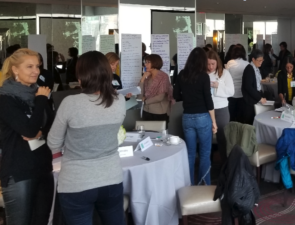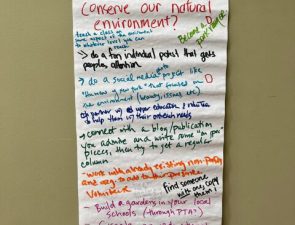Christine Mosich has a passion for self-improvement. It began after a near-death experience when she was 17 years old. Preparing for the worst, she received her last rites in an intensive care unit.
After recovering from the terrifying brush with death, Christine feels incredibly blessed to be alive. The incident taught Christine the value and fragility of life and she vowed to make choices that honored her second chance. That’s why Christine takes “living life to the fullest” seriously and is strategic about making life choices that align with her values.
Ever since that incident, she made sure to be present with friends and family and make time for things that brought her joy. Her desire to make the most of the life drew her to the Design Your Life Workshop.
“I want to make sure that I’m living my life to the fullest. To me, work isn’t everything but I still wanted to further explore my interests and find a career I was passionate about. For me, it’s all about work-life integration.”
Here is how the Design Your Life Workshop helped her do, just that.
Part 1: Life Design
Christine Mosich attended the Design Your Life for Women event in San Diego in January of this year. The timing of the event was perfect for Christine as she and her fiancé Kyle were in the process of figuring out how to move home to be closer to family and still find meaningful careers in their fields of choice.
What advice do you have to offer other dual-career couples facing challenging design problems?
Think about your needs as an individual first. Identify what you need to have in your life and your career to live happily. Then, prioritize those different components and identify what Christine likes to call non-negotiables. Once you’ve identified your non-negotiables for both your life and your career, share these with your partner and discuss what action steps you can take to better design the life you’ve imagined. Work with your partner to take small steps toward your vision and find ways to hold each other accountable to that vision in the long-term.
Taking the time to individually reflect on your workview and lifeview will allow you to have more meaningful discussion with your partner.
What does your new life design look like?
Christine and her fiancé have recently moved back home to the Central NY area and have started new jobs in similar fields they worked in while living in South Carolina. Christine has started her new role as a Career Services Assistant Director at SUNY Oswego and her fiance has transitioned from the United States Air Force into the Air National Guard. Christine and Kyle love being closer to their families and feel blessed to have found career opportunities where they both feel fulfilled!
Part 2: Work Design
Christine has been navigating a non-linear career path her entire life and has recently started to look for ways to incorporate her passions more into her work in Higher Education. The Design Your Life Workshop provided Christine with reassurance and helped her to start identifying ways that she could design her dream occupation with her various interests in her current role.
What did your odyssey plans look like?
Christine had three odyssey plans that were all very different! One included her current role in Higher Education, one included going on and becoming a College of Education faculty member at an institution and one included a Behavioral Scientist like position that incorporated conducting global positive research. After crafting her Odyssey Plans, Christine looked for themes within all three and noticed immediately that working with people and traveling were things that were included in each plan. In her new role, Christine is actively looking for opportunities to incorporate these themes into her work. While she learns all that encompasses her new role, she is constantly brainstorming ways to integrate travel while still developing relationships with her students.
Were there any key turning points in your story?
My older sister Amanda has known that she wanted to be a veterinarian since she was ten years old. I, on the other hand, wasn’t fully sure what I wanted to do and have jumped around exploring multiple interests over the years. Thinking back to when I was younger, I wanted to be a creative writer or a wedding planner. Then, I wanted to be a teacher, I wanted to work in higher education with college students and now I’m determined to design a career path that encompasses all my passions and still allows me to help others.
My aha moment at the workshop was when I realized that my career doesn’t have to be linear or singular, like my sister’s. I could have 3, 4, or 5 odyssey plans and that was okay. It was reassuring to see other women at different stages of their careers making bold career moves and it reminded me that it is okay to acknowledge new interests and find ways to incorporate them into my work life view.
What would you tell others about the life design process?
First, change doesn’t have to be huge. Moving forward in the right direction can mean one small step, a small change that will point you in the right direction.
Second, don’t put limitations on your odyssey plans. Give yourself the freedom to dream big with the third odyssey plan and don’t let your resources or confidence hold you back from designing that crazy great life. When I looked back on my third odyssey plan, I thought, “How can I take these extremely desirable components and make it part of my life now?” It felt empowering to be in a mindset where I didn’t have limitations.
How have you used the life design tools at work?
One of my favorite life design tools that I used when I left my role at the University of South Carolina was the Good Time Journal. I spent time each day logging my activities at work to help me better understand what fueled or drained my energy. I even asked a few teammates to complete the journal for me and share their perceptions of what tasks affected my energy as a professional. I compiled their thoughts and plan to utilize them in my new role to create a position that includes the work responsibilities that I enjoy.












